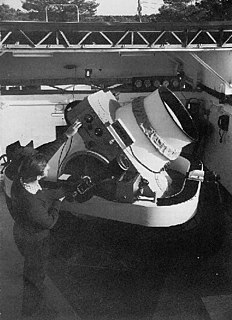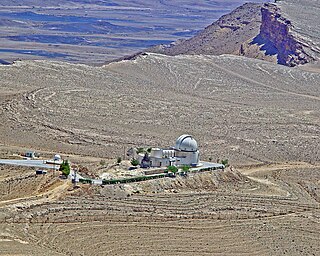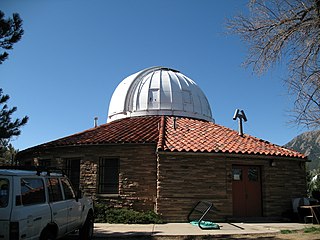
Vanguard 1 is an American satellite that was the fourth artificial Earth-orbiting satellite to be successfully launched ; it was launched 17 March 1958. Vanguard 1 was the first satellite to have solar electric power. Although communications with the satellite were lost in 1964, it remains the oldest human-made object still in orbit, together with the upper stage of its launch vehicle.

Yerkes Observatory is an astronomical observatory located in Williams Bay, Wisconsin, U.S.A. It was operated by the University of Chicago Department of Astronomy and Astrophysics from its founding in 1897 to 2020. Ownership was transferred to the non-profit Yerkes Future Foundation (YFF) in May 2020, which began restoration and renovation of the historic building and grounds. Re-opening for public tours and programming began May 27th, 2022.

Vanguard 2 is an Earth-orbiting satellite launched 17 February 1959 at 15:55:02 GMT, aboard a Vanguard SLV-4 rocket as part of the United States Navy's Project Vanguard. The satellite was designed to measure cloud cover distribution over the daylight portion of its orbit, for a period of 19 days, and to provide information on the density of the atmosphere for the lifetime of its orbit. As the first weather satellite and one of the first orbital space missions, the launch of Vanguard 2 was an important milestone in the Space Race between the United States and the Soviet Union. Vanguard 2 remains in orbit.

The Oak Ridge Observatory, also known as the George R. Agassiz Station, is located at 42 Pinnacle Road, Harvard, Massachusetts. It was operated by the Center for Astrophysics | Harvard & Smithsonian as a facility of the Smithsonian Astrophysical Observatory (SAO) from 1933 until August 19, 2005.

A Schmidt camera, also referred to as the Schmidt telescope, is a catadioptric astrophotographic telescope designed to provide wide fields of view with limited aberrations. The design was invented by Bernhard Schmidt in 1930.

The United States Space Surveillance Network (SSN) detects, tracks, catalogs and identifies artificial objects orbiting Earth, e.g. active/inactive satellites, spent rocket bodies, or fragmentation debris. The system is the responsibility of United States Space Command and operated by the United States Space Force.

Joseph Nunn (1905–1968) was an American engineer.

The Florence and George Wise Observatory is an astronomical observatory owned and operated by Tel Aviv University. It is located 5 kilometers west of the town of Mitzpe Ramon in the Negev desert near the edge of the Ramon Crater, and it is the only professional astronomical observatory in Israel.

James Gilbert Baker was an American astronomer and designer of optics systems.

Mount Laguna Observatory (MLO) is an astronomical observatory owned and operated by San Diego State University (SDSU). The telescope was operated in partnership with the University of Illinois at Urbana-Champaign (UIUC) until 2000. MLO is located approximately 75 kilometers (47 mi) east of downtown San Diego, California (USA) on the eastern edge of the Cleveland National Forest in the Laguna Mountains on the SDSU Astronomy Campus near the hamlet of Mount Laguna. MLO was dedicated on June 19, 1968, seven years after SDSU's Department of Astronomy became an independent academic department of SDSU's College of Sciences. The dedication took place during the 1968 summer meeting of the Astronomical Society of the Pacific. Currently SDSU is working with University of Kansas (KU), and UNC Chapel Hill on various projects.

Pine Mountain Observatory (PMO) is an astronomical observatory owned and operated by University of Oregon Department of Physics. The facility is located 26 miles (42 km) southeast of Bend, Oregon (USA) in the Deschutes National Forest near the summit of Pine Mountain.

Sommers–Bausch Observatory is an astronomical observatory located on and owned by University of Colorado Boulder. The building was initially completed in 1953 and named after Elmer E. Sommers and Carl L. Bausch.

Michigan State University Observatory is an astronomical observatory owned and operated by Michigan State University. It is located south of the Michigan State University campus in East Lansing, Michigan (USA), near the corner of Forest Rd and College Rd. It has a Cassegrain telescope in its single dome. Built by Boller and Chivens, the Michigan State University telescope was commissioned in 1969 and entered regular operation in 1970. In 1974, what was at the time a state-of-the-art Raytheon Microcomputer was installed to function as a data gathering and control system. Originally, single channel photoelectric photometry and photography using plates or film were the means of acquiring data. The observatory was closed from 1981 until 1986, at a time when the university was having financial difficulties. It was reopened in the spring of 1986 on the occasion of the return of Comet Halley and has been in regular operation ever since. Since the 1980s, a CCD camera has been employed as the main instrument and the Raytheon computer has been retired. The International Astronomical Union has assigned the MSU Observatory identification code 766.

The Hirsch Observatory is an astronomical observatory at Rensselaer Polytechnic Institute (RPI) in Troy, New York. It is located on the roof of the Jonsson-Rowland Science Center and is used by members of the Rensselaer Astrophysical Society as well as astronomy students in laboratory exercises. It is frequently opened to the community for public viewing sessions. The observatory's main dome contains a 16" Cassegrain Reflector, with a CCD camera and fully computerized controls. The observatory also owns a variety of smaller scopes and a SBIG Spectrograph. The spectrograph has been used to catalog bright solar spectrum as part of an effort to create an online digital database for astrophysical research. The current director of the observatory is Professor Heidi Newberg.

Operation Moonwatch was an amateur science program formally initiated by the Smithsonian Astrophysical Observatory (SAO) in 1956. The SAO organized Moonwatch as part of the International Geophysical Year (IGY) which was probably the largest single scientific undertaking in history. Its initial goal was to enlist the aid of amateur astronomers and other citizens who would help professional scientists spot the first artificial satellites. Until professionally manned optical tracking stations came on-line in 1958, this network of amateur scientists and other interested citizens played a critical role in providing crucial information regarding the world's first satellites.

Itek Corporation was a United States defense contractor that initially specialized in camera systems for spy satellites and various other reconnaissance systems. In the early 1960s they built a conglomerate in a fashion similar to LTV or Litton, during which time they developed the first CAD system and explored optical disc technology. These efforts were unsuccessful, and the company shed divisions to various companies, returning to its roots in the reconnaissance market. The remaining portions were eventually purchased by Litton in 1983, and then Hughes, Raytheon, and Goodrich Corporation.
Project Space Track was a research and development project of the US Air Force, to create a tracking system for all artificial satellites of the Earth and space probes, domestic and foreign.
Tortugas Mountain Observatory (TMO) is an astronomical observatory owned and operated by New Mexico State University (NMSU). It is located on Tortugas Mountain, also known locally as 'A' Mountain, in southern New Mexico (USA), approximately 8 kilometers (5.0 mi) southeast of Las Cruces and 4 kilometers (2.5 mi) east of the NMSU campus. Founded in 1963 under the supervision of Clyde Tombaugh, the observatory focused on observing the planets. Much of the information captured at TMO is now available through the Planetary Data System's Atmospheres Node, which is managed by NMSU. The two-dome observatory building was completed in 1964, though observing began with one of the telescopes in 1963. A second building, with a larger single dome, was completed at the opposite end of the ridgeline of Tortugas Mountain in 1967. Regular use of TMO ceased in 1999 or 2000, but the observatory equipment was not dismantled. In 2008 it was used for the Lunar CRater Observing and Sensing Satellite project. In 2010, efforts to revive the observatory for use by the American Association of Variable Star Observers began. As of 10 June 2011, work on project was reported to be 60-75% done.

Lindheimer Astrophysical Research Center was an astronomical observatory used for teaching and research, located on the Evanston, Illinois campus of Northwestern University. The structure was built in 1966 and was demolished in 1995.

The Hume Cronyn Memorial Observatory is a public astronomical observatory located on the campus of the University of Western Ontario, in London, Ontario, Canada.



















